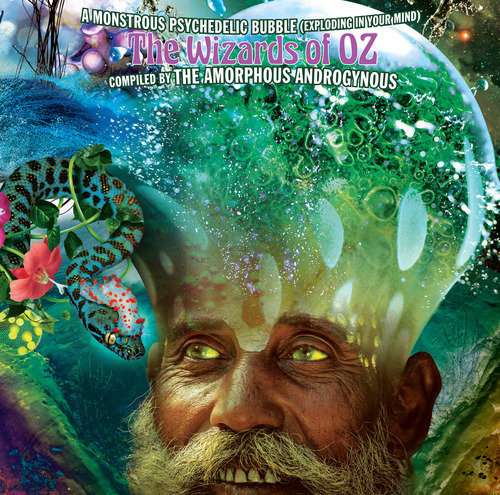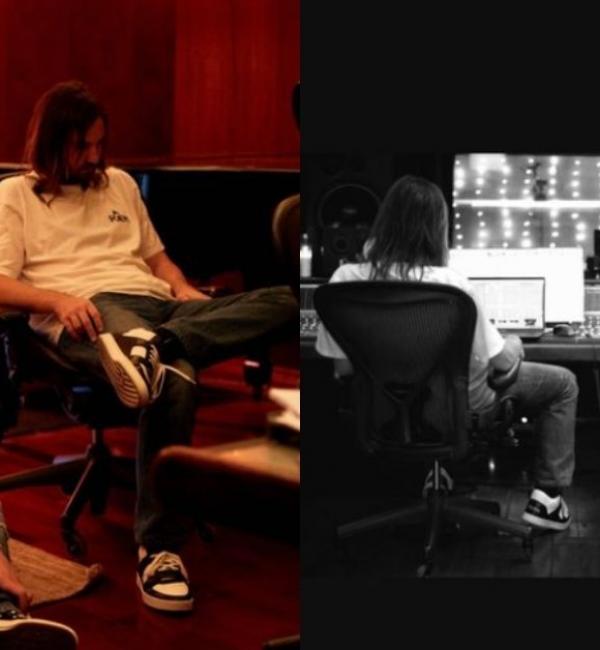
Cycle 1: ENTER THE SWAMP

Rock, sure. Pop, definitely. Even the kind of AM-radio classical that hisses out of car speakers in late afternoon commute. All have their casual listeners. Psychedelic rock however, is not a genre that is generally attended by occasional fans. My (heavily conditioned) preconceptions of the Very Serious Psych Enthusiast are not so much about humans who enjoy listening to psychedelic rock, but humans that have been perfectly absorbed by it.
[Author’s Note: More specifically I’m talking about the person that listens to Syd Barrett in the same way that a 14 year old girl listens to Katy Perry and whose music collection was promoted long ago from lifestyle soundtrack to lifestyle compass. My heavily conditioned preconceptions see this person as older, a kind-of sinewy souvenir, damaged in slow, irreversible ways. Looking not so much haggard as chewed-on by life.]
In a pre/misconceived nutshell, I was pretty sure that the Wizards of Oz compilation was made to be purchased on both vinyl and CD (for the car) by the above listener, and to be wholly ignored by me. A scan of the track listing seemed to confirm the distance of the whole thing to anything even tenuously modern or relevant: ‘Love is the Law’ – Sons of the Vegetal Mother, ‘12lb Toothbrush’ – Madder Lake, ‘Waves of Aquarius’ – Kanguru. But the operative word here is ‘scan’. A cursory glance turns over the familiarly expansive, astrological allusions that have become the faded back wall that psych rock projects itself onto. My preliminary admission here is that until now, I’ve looked no further. This compilation is the first truly close listening I’ve ever given psychedelic rock. Predictably, the names ‘Pond’ and ‘Tame Impala’ provided an access point, a reason to listen harder.
[Author’s Note: Part of the problem with the mass public appeal of psychedelic rock is that it’s intentionally nebulous, configured to exemplify a kind of ‘otherness’ which results in songs that are of Olympic length and structurally arcane and acts with names so involved that they barely ever stick to the walls of any regular listener’s brain. ‘The Amorphous Androgynous’ is a perfect example, a name that is itself an alias of Garry Cobain and Brian Dougans’ ‘Future Sound of London’. ‘The Amorphous Androgynous is one of thirty-one different aliases FSOL has performed under since the late 80s. Other than ‘A Monstrous Psychedelic Bubble (Exploding in Your Mind)’ they’ve released many other easy-to-remember titles such as ‘The Peppermint Tree and Seeds of Superconsciousness’ and ‘A Gigantic Globular Burst of Anti-Static’.]
But I’m glad I chose to listen harder. What Cobain and Dougans have unearthed on the Wizards of Oz really are gems. Doug Jerebine’s Zepplinesque swagger and Hendrix-powered lead guitars come together on his two tracks (‘Midnight Sun’ and ‘Ain’t So Hard to Do’) like an electrical storm. Equally irresistible is Cybotron’s extraterrestrial synth work, soaring and arpeggiating eerily over some of the compilation’s most kinetic percussion. And this is the very tip of the rainbow. Cobain told Mojo that “the question that arose with increasing regularity was, ‘Why have we not heard this before?!’” [sic]. I’m asking the same question. Particularly as someone who was dragged up in the Australian music landscape where these gems were forged. Although the music isn’t really tethered to place as such, actually it’s pretty much geographically rootless, favouring landscapes that range from the semi to the fully imagined. It does, however, have an interesting relationship with time.
Cycle 2: THE FUTURE PAST

Here are some words that don’t belong to me:
“Here in this universe, people just don’t know what’s going on. Somebody turn them on. All of you turn them on.” – SJC Powell, ‘Governor Lane’.
“If your life’s getting dull and grey, colour your mind, colour your mind. Mum and Dad have gone away, pull down the blind, and colour your mind” – Tyrnaround, ‘Colour Your Mind’.
“Well I know you couldn’t get much higher and I know you could burn my fire” – Kongress, ‘Eyes of Witness’.
There’s something elastic that happens when songs about the imagined future are sung in an expired vernacular. It’s a kind of reminder that the future is a figment of the present; always offering a better view of the place it was projected from than what it’s attempting to estimate. The above quotes could only be from the 70s— where escape from “dull and grey” societal norms into a chemically activated, technicolor ‘reality’ was central to the coming-of-age experience of the time.
[Author’s Note: In a nutshell: It’s a fictional universe that bleeds fact.]
The Future Sound of London AKA The Amorphous Androgynous (AKA ect) are often touted as having created such a universe over the last twenty years. It’s tangential, sprawling between sample-based dance and electronica to psychedelia and prog rock. And boasting a catalogue that leans heavily on sampling, there’s a whole lot of temporal elasticity to FSOL/AA’s universe too. Despite the heavy use of preexisting music (in the form of samples), there’s no stagnation in the work of FSOL/AA. It’s about selecting and remixing—a constant reimagination, and (particularly pertinent to the Wizards of Oz compilation) reinvigoration.
Cycle 3: EXPANDING IN YOUR MIND

Wizards of Oz is more than just a time capsule. In fact, even if it didn’t have a smattering of new bands across it’s track listing I’m still not sure it would even qualify as a time capsule given the wholesale anonymity of most of the compilation’s artists. It’s a time capsule for maybe 20 guys. Which is, of course, why it’s so great—we haven’t heard it before, it’s not just driven by the seduction of nostalgia, it’s not a static document. It’s showing most people stuff they’ve never heard.
[Author’s Note: Most young-middle aged Australians will know four names. Tame Impala and Pond and more tenuously, Ash Grunwald and Russell Morris. ‘The Real Thing’ is literally the only song Russell Morris is popularly known for. You know it. Listen to Gold FM for more than fifteen minutes straight and you’ll hear it. My only personal young Australian memory of Morris was when he headlined some kind of school performance day at my outer suburban, Church of England high school, where he was (I shit you not) billed as: ‘Russell “the Real Thing” Morris’. I think it was a rain out. Ash Grunwald, a private-school Lutheran to My C. of E, still just sounds like he looks like a backpacker. Which he does.]
And this lack of stasis is something that can be more broadly applied to FSOL/AA as a musical entity. The duo’s musical lifespan has eclipsed the dawn of the internet, and continues to live through the transference of culture events onto the struts of its web. And through it they’ve been unceremoniously ahead of the curve or recursively ‘behind’ (Wizards of Oz being a prime example). They mixed and presented diffuse three-hour long radio shows broadcasted on Manchester’s Kiss FM, and broadcasted live to radio stations using the circuit-switched telephone network ISDN around the world, their 1994 album (appropriately named) ISDN. They’ve produced dance music (sampled electronica, breakbeat, house, acid techno), volumes of soundscapes and of course, an ever-expanding catalogue of psychedelia. The Wizards of Oz compilation in this way is so much like the musical experience of the men who selected and mixed it. It’s not intended to be a remembrance so much as an exhumation of music that (mostly) never reached a wide enough audience to even be forgotten. It’s not so much an explosion in our minds, as the title of the compilation may suggest. It’s more like an expansion in our minds. Sometimes it’s almost unbelievably catchy (Kongress/Doug Jerebine/Cybotron), sometimes it takes some harder listening (Rob Thomsett/Krozier and the Generator/Pip Proud). But it’s all daaamn worth it.
[OVERALL RATING: 4 Glowing Mucoidal Spheres of Galaxial Wisdom Out of
5]

The Wizards of Oz - A Monstrous Psychedelic Bubble (Exploding In Your Mind)
mixed and compiled by The Amorphous Androgynous is available now where all mind melting records are sold.





